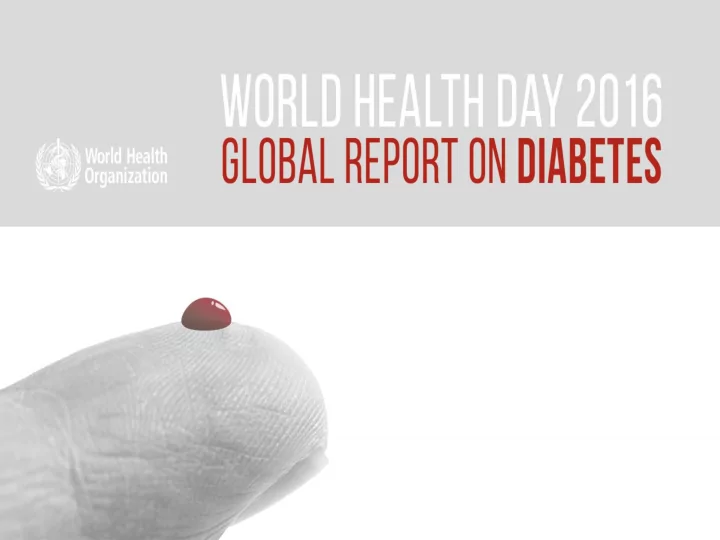

Scope of the report Burden of diabetes Preventing diabetes Managing diabetes National response Recommendations
BURDEN OF DIABETES
Diabetes is a serious, chronic disease characterized by elevated blood glucose occurs either when the pancreas does not produce enough insulin (type 1) or the body cannot effectively use the insulin it produces (type 2).
Diabetes is one of the four major NCDs Causative risk factors Harmful Tobacco Unhealthy Physical use of use diets inactivity alcohol Heart disease Non-communicable diseases and stroke Diabetes Cancer Chronic lung disease
Risk factors Type 1 Exact causes are unknown. Type 2 Risk is determined by genetic and metabolic factors Overweight/obesity and physical inactivity are the strongest risk factors Fetal & early childhood nutrition affect future risk
Complications of diabetes
Rise in diabetes 422 million 108 million 1980 2014
Rise is faster in low- and middle - income countries 10% 8% Prevalence 6% Low-income Lower middle- 4% income Upper middle- income High-income 2% 0% 1980 1982 1984 1986 1988 1990 1992 1994 1996 1998 2000 2002 2004 2006 2008 2010 2012 2014
Increase in diabetes is most marked in the WHO Eastern Mediterranean Region
Mortality from diabetes Deaths due to 43% of deaths occurred high blood glucose under the age of 70 years 3.7 Million Deaths due to diabetes 1.5 Million
Economic impact of diabetes Catastrophic medical expenditure significantly higher in people with diabetes. Direct annual cost of diabetes globally > US$ 827 billion. Losses in GDP worldwide estimated to be US$ 1.7 trillion from 2010 to 2030
Diabetes and the global NCD agenda SDG target- One third reduction 2011 UN Political NCD Global NCD Targets for in premature Declaration on Action Plan 2025 – Halt the mortality from NCDs 2013-2020 rise in Diabetes NCDs (including Diabetes)
PREVENTING DIABETES
Overweight and obesity increasing 2014 1 in 3 overweight 1 in 10 obese
Preventing type 2 diabetes at the population level Multisectoral approaches to reduce the prevalence of modifiable diabetes risk factors A combination of fiscal policies, legislation, changes to the environment and raising awareness of health risks can promote healthier diets and physical activity.
Healthy work places
School-based approach
Preventing type 2 diabetes in people at high risk Diabetes can be delayed or prevented in people who are overweight and have impaired glucose tolerance (IGT). Diet and physical activity are more effective than medication. The high-risk approach needs to be implemented in accordance with available resources.
MANAGING DIABETES
Diagnosing diabetes Diabetes is diagnosed by measuring glucose in blood Fasting 2 hours after a 75g oral load of glucose measuring glycated haemoglobin (HbA1c) High proportion of type 2 diabetes is undiagnosed.
Management of diabetes Good management can prevent complications and premature death using: standard guidelines and protocols (WHO Package of Essential NCD interventions) small set of generic medicines diet and physical activity patient education about self-care regular screening for early detection and treatment of complications.
Access to affordable insulin People with type 1 diabetes require insulin for survival. People with type 2 diabetes often need insulin Low-income countries generally pay most for insulin while high- and middle-income countries pay least. Only 23% of low-income countries report that insulin is generally available.
Early detection and treatment of complications End-stage renal disease Measurement of urine protein progression to kidney failure can be slowed by essential drugs Cardiovascular diseases Measure and control cardiovascular risk factors Blindness Periodic eye examinations and timely laser photocoagulation Lower limb amputation Proper footwear and regular examination of feet Provide rehabilitation
Integrated management of diabetes and other chronic health conditions Diabetes management should be integrated with management of other NCDs, and in some settings with tuberculosis and HIV/AIDS.
NATIONAL RESPONSE
National capacity for prevention and control of diabetes (NCD CCS 2015- 177 countries) 156 countries have a national diabetes policy, plan or strategy, only 127 are funded and operational. 68% of countries have operational policies for diet and physical activity. < 50% of countries have conducted a national, population-based survey with measurement of blood glucose status within the past 5 years.
National capacity for prevention and control of diabetes (NCD CCS 2015- 177 countries) Only 47% of countries report full implementation of guidelines for management of diabetes. Only 1/3 of low- and lower-middle income countries have all three basic technologies in PHC blood glucose urine strip for glucose/ketone and height and weight measurement Blood glucose measurement is generally available in primary care in 50% of low- income countries.
RECOMMENDATIONS
Recommendations National mechanisms • Establish high-level multisectoral commissions • Strategic leadership, engagement of Build capacity of health stakeholders, implement policies and foster ministries accountability Prioritize prevention of • Life-course approach, create supportive overweight and obesity environments, use fiscal policies and legislation • Enhance capacity of primary health care, Strengthen health systems national protocols for management, improve access to affordable medicines. Address gaps in knowledge • Outcome evaluations, operational research base • Collect, analyse and use representative data, Surveillance and monitoring develop and strengthen diabetes registries if feasible.
WHO response Access to Prevention Management essential Surveillance medicines Ending Monitor Clinical Risk factor childhood availability guidelines surveys obesity and price Fiscal Update of Country Strategic policies, diagnostic capacity and procurement legislation criteria response Settings- Review and Diabetes Mortality based update WHO registries estimates approaches EML
Recommend
More recommend